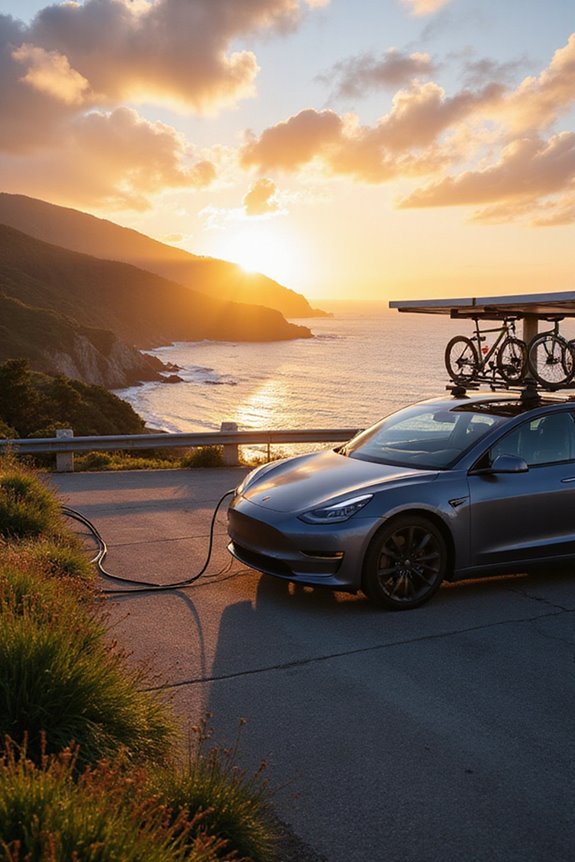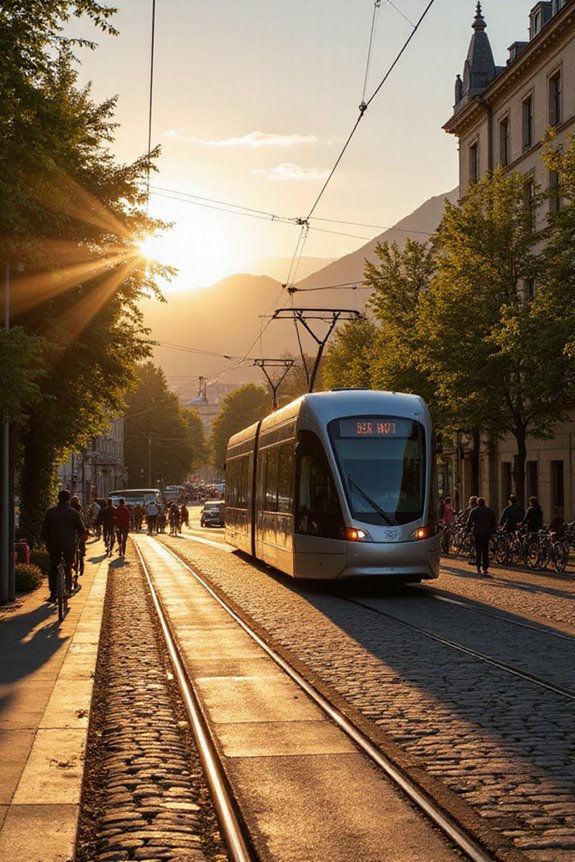When I think about the most sustainable transportation options, I can’t help but appreciate how electric vehicles, public transit, and carpooling can really shake things up. Plus, who doesn’t love the idea of hydrogen cars that just exhale water? And let’s not forget friendly bikes or e-scooters zipping around town! They all help clear the air and keep costs low. Trust me, there’s so much more to explore in this green journey!
Key Takeaways
- Walking and biking are zero-emission, eco-friendly options that promote health and reduce urban pollution.
- Public transportation is cost-effective, lowers greenhouse gas emissions, and encourages active lifestyles for better health.
- Shared mobility and carpooling decrease gas costs and congestion while fostering social connections and cleaner air.
- Hydrogen fuel cell vehicles emit only water vapor, providing a sustainable alternative with quick refueling times.
- Improved battery recycling and innovations in EV production can enhance the sustainability of electric vehicles.
Electric and Battery-Powered Vehicles

When we think about electric and battery-powered vehicles, it’s easy to get swept up in the excitement of change, right? These vehicles promise a greener future, but it’s essential to reflect on battery production. Producing batteries generates around 46% of the total carbon emissions of an EV. It’s kind of a mood killer, isn’t it? Plus, the mining for lithium, cobalt, and nickel can devastate local ecosystems—yikes!
Now, let’s not forget recycling technologies; only 5% of batteries get recycled, which is frustrating. If we improve these technologies, we could recover valuable materials, cut down on new mining, and lessen our environmental impact. So, while the future looks bright with EVs, we’ve got some serious challenges to tackle.
Public Transportation Systems

Have you ever wondered how much of a difference public transportation could make in our daily lives? Imagine hopping on a bus and knowing it’s cutting greenhouse gas emissions, all while giving you a guilt-free, eco-friendly ride. Public transit isn’t just a cost-effective way to travel; it’s a ticket to healthier living, too! Think of those extra steps you take to the station, helping reduce obesity and heart disease. Investing in infrastructure is essential—without it, our transit systems can’t keep up with demand. We might even save a ton of oil and improve urban air quality! So, let’s embrace public transit together, not just for the planet, but for a healthier, more connected community. Who’s in?
Shared Mobility and Carpooling

While it might seem easier to just hop in my car and speed off to my destination, shared mobility and carpooling are growing on me more each day. I mean, who knew that sharing a ride could have such awesome ride-sharing benefits? Not only does it cut down on my gas costs, but it also helps tackle urban congestion. I’m amazed at how much cleaner the air feels when fewer cars are on the road. Plus, think about all those new friends I could make, sharing stories while we cruise along! With shared mobility on the rise, we’re witnessing real change—more people opting to share rides means a greener, more connected future. And honestly, isn’t that worth the little extra effort?
Hydrogen Fuel Cell Transportation

You know, just when I thought I was getting comfortable with carpooling, along came hydrogen fuel cell transportation to shake things up a bit! Imagine cruising around in a vehicle that emits only water vapor—no harmful pollutants in sight. That’s what fuel cell electric vehicles (FCEVs) offer, and their fuel cell efficiency is astounding. You can refuel in just three to five minutes, like at a gas station, but cleaner! It’s thrilling to think about the potential hydrogen infrastructure developing all around us, powering everything from delivery vans to even boats! Of course, there are challenges ahead, like expanding production and building those refueling stations, but the future looks bright for hydrogen as a game-changer in sustainable transport!
Active and Micromobility Options

Active and micromobility options are transforming the way we think about getting around, and trust me, it’s not just buzzwords. Walking is a fantastic choice—it’s zero-emission and keeps us healthy, plus it’s a simple way to enjoy fresh air. Then there’s biking, another eco-friendly mode that’s perfect for short trips; it cuts pollution while keeping our communities connected to public transit. And let’s not forget about micromobility solutions like e-scooters and e-bikes! They zip us around urban areas, making those pesky first- and last-mile gaps a breeze to cross. All these active transportation methods make me feel like I’m contributing to cleaner air and better health, while also having a little fun along the way.
Frequently Asked Questions
What Are the Costs Associated With Electric Vehicle Infrastructure Development?
I’ve found that developing electric vehicle infrastructure involves various costs. Charging stations can be pricey, and infrastructure funding through grants and tax credits helps offset these expenses, ensuring a smoother shift to electric mobility for everyone.
How Do Transportation Emissions Impact Climate Change and Public Health?
Transportation emissions seriously affect climate change and public health. They harm urban air quality and disproportionately impact vulnerable communities. I believe achieving transportation equity is essential for a healthier future and cleaner air for everyone.
What Policies Promote Sustainable Transportation in Urban Planning?
To promote sustainable transportation, I believe we need infrastructure incentives, zoning regulations, and safe bike lanes. By prioritizing these elements, we encourage walking and cycling, fostering vibrant, interconnected communities that ultimately reduce our reliance on cars.
How Is Waste Management Integrated Into Transportation Sustainability Efforts?
In my view, integrating waste management into transportation sustainability efforts is essential. By focusing on waste reduction and implementing recycling programs, we can enhance efficiency, lower emissions, and foster a healthier environment for everyone.
What Role Do Renewable Energy Sources Play in Transportation?
Imagine a sunny road where electric cars glide effortlessly, powered by renewable energy. I see transportation integration transforming our world, reducing emissions, and creating a cleaner future through the harmony of clean power and innovative mobility solutions.




